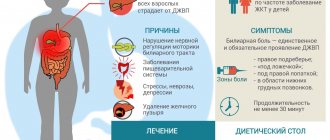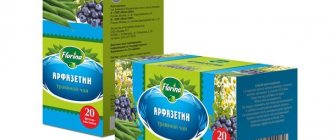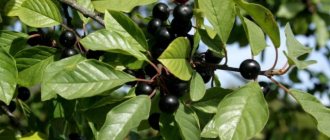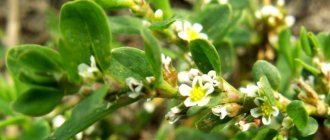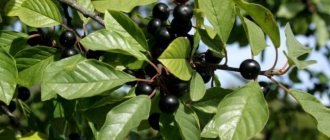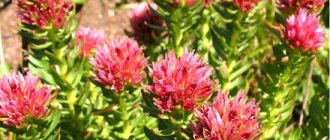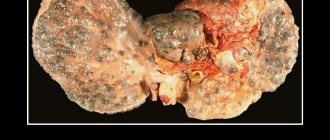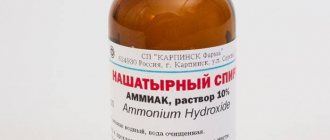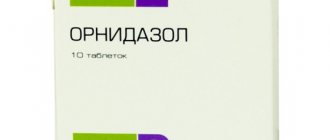Stagnation of bile occurs in diseases of the liver, gallbladder, and bile ducts. The consequences of cholestasis are diseases of the digestive system, stone formation in the gall bladder, and decreased immune status. Complex therapy necessarily includes medications and diet. A choleretic herbal mixture has a good effect. An infusion based on it is convenient to prepare at home. The attending physician must choose the appropriate remedy; if there are contraindications, analogues are prescribed. Compliance with the dosage will help avoid side effects.
Instructions for use
Bile produced in the liver is needed by the body for normal digestion. In addition, it helps destroy bacteria. The gallbladder accumulates it and, if necessary, delivers it to the duodenum to digest food.
At the slightest malfunction of the liver or gallbladder, excessive accumulation and stagnation of bile occurs. Its excess does not leave the body on its own. This is where various choleretic preparations come to the rescue.
pharmachologic effect
Medicinal herbs included in the composition help to liquefy thick bile secretions and effectively remove them from the body. They not only remove excess bile from the body, but also improve the condition of the liver, normalize its function, and tone the muscle layer of the gallbladder. Such medicinal preparations perfectly relieve spasms and severe pain, improve appetite, and increase pressure in the digestive tract. This helps to quickly remove excess bile from the intestines.
Indications for use
Similar drugs are prescribed for the treatment of chronic cholecystitis or hepatitis, anorexia and digestive disorders.
Disorders of the liver, bile ducts and bladder are accompanied by the following symptoms:
- constant bitterness in the mouth;
- a feeling of heaviness on the right side of the abdomen due to an enlarged liver;
- diarrhea followed by diarrhea;
- stool becomes white and urine becomes very dark;
- belching;
- severe pain in the right hypochondrium;
- drowsiness;
- vomiting mixed with bile;
- indigestion.
Herbs cope well with dyskinesia of the bile ducts, infectious inflammation of the biliary tract (cholangitis), and impaired bile patency. Help relieve nausea, spasms and pain in the gallbladder.
Often, choleretic herbs are prescribed for the treatment of pancreatitis (inflammation of the gallbladder). With this pathology, the enzymes produced by the pancreas do not enter the intestines, but corrode the gland itself. Herbal decoctions help improve food digestion and are used in the treatment of giardiasis.
They are not used as an independent medicine, but only as part of a complex treatment, and only as prescribed by a doctor. You should not delay your visit to the doctor, because such symptoms often lead to the development of liver failure and cirrhosis.
Mode of application
Choleretic collection will be beneficial only if properly prepared. This is quite easy to do. It is necessary to pour a spoon (tablespoon) of dry raw materials with a glass (200 ml) of boiling water and cook over low heat for about 15-20 minutes. Then, the finished drink is infused for about an hour and carefully filtered.
During the day, you need to drink approximately 200-300 ml of the decoction in several doses, and treatment is continued for a month. If the collection comes in bags, then take two bags per glass of boiling water and leave for 15 minutes. The further application scheme is the same as when brewing in the usual way.
Also watch a video with tips on how to properly brew and take herbal infusions:
Release form, composition
Choleretic preparations are sold in pharmacies, both in the form of filter bags and packaged in 100 grams in cardboard boxes. There are three types of fees: No. 1, No. 2 and No. 3.
The first fee includes:
- mint leaves;
- coriander seeds;
- three-leaf watch;
- immortelle.
Mint, due to its bitter taste, stimulates the liver, and three-leaf watch normalizes impaired digestion. Coriander facilitates the removal of bile from the intestines. Immortelle is considered the best anti-inflammatory agent, dilutes bile, lowers bad cholesterol in the blood, and reduces pain.
Collection No. 2 includes the same herbs (mint, coriander and immortelle). Only instead of a three-leaf watch, it contains yarrow. This unique plant is part of a huge number of natural medicines. Yarrow can quickly relieve inflammation, spasms and pain, accelerates the excretion of bile
Collection No. 3 includes:
- chamomile flowers;
- mint;
- tansy;
- calendula;
- yarrow.
Tansy actively fights not only inflammation, but also germs and bacteria, and chamomile has a strong calming and antiseptic effect. Calendula is also an anti-inflammatory plant that strengthens the immune system and increases the body's resistance.
Interaction with other drugs
Such medicinal preparations can be combined with taking any medications. No studies have been conducted on this matter, but herbal infusions, as a rule, have no effect when used together with medications.
Contraindications
Despite the low toxicity of choleretic herbs compared to synthetic drugs, their use is sometimes limited. Increasing the flow of bile is not recommended if you have gallstones. This can cause the stone to enter the bile ducts and cause them to become blocked. For gallstone disease, it is recommended to use herbs with an anti-inflammatory effect that help partially dissolve the stones - examples of such plants are given later in the article.
Choleretic collection may cause side effects in the following cases:
- peptic ulcer (stomach or intestines);
- exacerbation of inflammation of the gallbladder (cholecystitis), pancreas;
- abnormal structure of the organ that prevents the release of bile;
- tumor diseases of the biliary system;
- viral hepatitis;
- acute diarrhea (increased secretion of bile will increase it).
Herbal medicines are recommended to pregnant women with caution, after first making sure that there are no stones in the gallbladder. After all, if a stone passes, surgery during pregnancy is undesirable. Choleretic herbal infusions are prescribed for children, but in a smaller dosage, depending on the age and weight of the child.
Side effects
Often, patients note that after taking such herbal drinks, they experience heartburn. Sometimes severe allergic reactions were observed, in the form of urticaria and itching.
Overdose
If the recommended dosage is significantly exceeded, symptoms such as persistent nausea, vomiting, diarrhea, increased blood pressure and headaches may appear.
Contraindications
Although these are natural herbal preparations, they are not harmless.
Choleretic preparations should not be used for the following ailments:
- duodenal ulcer;
- allergy to pollen (hay fever);
- cirrhosis;
- individual intolerance;
- cholelithiasis;
- exacerbation of pancreatitis;
- stomach ulcer;
- appendicitis;
- calculous cholecystitis.
Any of these diseases excludes the use of herbal drinks and requires consultation with a doctor.
During pregnancy
During the period of bearing a child, you should not drink such decoctions. The doctor can prescribe them only in the most extreme cases.
Herbs for gallstone disease
In the presence of stones, it is recommended to make mixtures of plants that normalize the functioning of the gallbladder without a sharp increase in the outflow of bile. Chamomile, knotweed, calamus, anise, and rose hips will help relieve inflammation, dissolve small stones, and provide first aid for pain and spasms.
Calamus root and anise can be found in pharmacies in the form of an alcohol tincture, 20 drops of which are recommended to be taken with meals.
Infusion and decoction of lingonberry leaves has a bile-liquefying effect and helps get rid of clots and stones. Tea made from thyme, mint, lemon balm, strawberry leaves and berries, and lavender flowers has the same effect. Depending on the availability of these plants, you can make various herbal infusions and take them in courses, remembering to consult a doctor and monitor the condition of the gallbladder.
Natural herbal remedies are good because they can be taken for a long time without harm to health. Comments from patients and specialists indicate the high effectiveness of herbal medicine if the instructions for use are followed. Herbal infusions, in the absence of contraindications, are prescribed to pregnant women and children. Medicinal plants are officially recognized as sources of substances beneficial to humans, which have a mild therapeutic effect on the body.
special instructions
In order for medicinal herbs to be beneficial and not cause adverse reactions, it is necessary to take into account some features of use. You should drink decoctions before meals, strictly following the brewing rules and dosage.
Impact on the ability to drive vehicles and operate machinery
It must be remembered that preparations that include immortelle can significantly increase blood pressure. People suffering from hypertension should be especially careful, especially when using preparations No. 1 and 2. Due to a sharp increase in pressure, severe headaches and dizziness, and loss of orientation are possible.
Pregnancy and lactation
During pregnancy and subsequent feeding, women are not recommended to use choleretic preparations. The doctor may prescribe them as a last resort, when the possibility of using medications is completely excluded.
Use in childhood
Children under 12 years of age are strictly prohibited from drinking decoctions. For older children, they are given strictly as prescribed by a specialist.
If kidney function is impaired
For kidney disease, this drug is contraindicated.
In case of liver dysfunction
Severe liver damage, cirrhosis, are also contraindications for taking choleretic preparations.
Conditions for dispensing from pharmacies
Any choleretic collection is sold in all pharmacies without a prescription.
How to cook and drink
It is simple to prepare a choleretic preparation prescribed by a specialist:
- 5-10 g of medicinal raw materials are poured with hot water (85-90°C) in an amount of 200 ml;
- tightly closing the lid, place in a boiling water bath for a quarter of an hour;
- After removing from heat, leave for at least 45 minutes;
- filter, if necessary, add water to the initial volume.
Prepare the infusion in a heat-resistant glass or ceramic container. Store in the refrigerator for no more than 48 hours.
If you use the collection in filter bags, take 1-2 pcs. per glass of water.
It is recommended to take the infusion according to certain rules:
- Shake thoroughly before use;
- drink within 30-40 minutes. before meals three times a day;
- The daily intake is one and a half glasses, a single dose is 100 ml.
For children over 12 years old, the volume is halved. The product from the refrigerator should not be heated; it is better to leave it at room temperature in advance.
It is correct to drink the choleretic mixture in small sips - this increases its effectiveness.
The duration of treatment is prescribed by the doctor. As a rule, it lasts no more than a month, in rare cases up to six months.
In addition to the plants included in choleretic pharmaceutical preparations, traditional medicine also uses others (dandelion, birch leaves, corn silk). When preparing mixtures of medicinal herbs yourself, you need to remember that before you start taking it, you need to consult a specialist.
Analogs
It is very easy to select drugs with a similar effect, since there are many of them available.
The most popular analogues:
- Gepabene;
- Holosas;
- Flamin;
- Fumeter;
- Curepar;
- Holagogum;
- Holagol.
Brewed corn silk, a decoction of their calendula and celandine flowers, and a rosehip drink have the same effect.
Watch the video for other recipes for treating the gallbladder using traditional methods:
Other recipes
In addition to standard herbal teas sold in pharmacies, you can prepare your own bile mixtures with the addition of the following plants:
- corn silk;
- barberry root;
- sagebrush;
- artichoke;
- common dandelion;
- birch leaves;
- milk thistle.
Corn silk is a universal remedy for the prevention and treatment of diseases of the gallbladder and liver. They help improve the composition of bile and increase its outflow, relieve spasm and inflammation.
Barberry contains the alkaloid berberine, which actively affects the gallbladder - relieves inflammation and increases tone. Dandelion root has a similar effect. Birch leaves can dissolve small stones, relieve inflammation and help get rid of infection.
Artichoke and milk thistle are considered one of the best plants for the prevention of liver diseases. They improve the composition of bile, help the liver work more actively, and restore its cells. Artichoke can reduce the amount of “bad” cholesterol, which is the main cause of thickening of bile and the formation of stones.
Wormwood is a rather poisonous plant, but in small doses it improves digestion, increases the secretion of gastric juice and the production of enzymes. The plant has an antiparasitic effect and is used to treat giardiasis.
Reviews
Most patients respond positively to choleretic preparations. They noted a significant improvement in their condition after just 2 weeks of regular use. Many patients noted that the best results can only be achieved with complex therapy, which includes not only taking herbal decoctions, but also mandatory adherence to dietary table No. 5 and the use of medications.
Olga: I was recently diagnosed with cholecystitis, and the doctor advised me to drink choleretic mixture No. 2. After a couple of weeks, my digestion and stool returned to normal, the unpleasant belching and bitterness in my mouth disappeared, the nausea disappeared, and the pain disappeared. Additionally, I took medications and tried to stick to proper nutrition.
If you have experience using similar herbal remedies, please leave a review to help other site visitors formulate an overall impression.
Price, where to buy
You can purchase the collection at any pharmacy. The price of choleretic collection No. 3 in packs of 50 g ranges from 57-73 rubles, the price of raw materials in filter bags is 38-71 rubles.
- Online pharmacies in RussiaRussia
ZdravCity
- Phytohepatol (Cholagogue collection No. 3) PharmaColor 2g filter pack.
20 pcs. JSC Krasnogorskleksredstva 87 rub. order
FAQ
- Where are herbs collected for harvesting? — We collect herbs in ecologically clean regions of the country and then make collections from them in a warehouse in the Rostov region.
- How do you store herbs for harvesting? — In order to preserve the beneficial properties of the collections as much as possible, we store them in specialized warehouses, where optimal levels of humidity and temperature are maintained. All herbs are mixed only by hand.
- How to make an order? — You can place an order by calling 8 804 333-74-23 — the call within Russia is free. Making purchases on our website is also easy: add the desired items to your cart, then enter your contact information in the form, select a delivery and payment method, and click on the “Place an order” button. Our manager will contact you shortly to confirm your order.
- How is the collection and parcel packaged? — We pack the collection in a special three-layer bag that preserves all the properties of the herbs. When submitting an application, you can request a certificate of conformity and an insert with a description and methods of using herbs.
buy now
ethnoscience
- Half a glass of unrefined vegetable oil is heated and drunk on an empty stomach. Lie on the heating pad on your right side until the heating pad cools down. Over the next 3 days, drink drinks made with rose hips in any quantity.
- Instead of sunflower oil, you can use lard with garlic without bread. It is eaten in the morning on an empty stomach and placed on a heating pad on the right side until it cools down. Over the next 3 days, drink decoctions and compotes from rose hips.
- Homemade beet juice. The beets, cooked until half cooked, are grated and squeezed through cheesecloth. The juice is drunk in sips half an hour before meals.
- Unroasted pumpkin seeds, store-bought or dried yourself. There are no restrictions on quantity. Caution is required during exacerbations of stomach diseases.
- Including parsley in any form in your diet. These will be tinctures and juices, additions to salads, first or second courses. Medicinal properties are preserved during heat treatment.
- Drinking regular hot drinking water before meals will help remove bile. The mechanism of action is based on relieving spasm of the pylorus and sphincter of Oddi.
- Sokolechenie. To prepare a healing drink, take equal volumes of radish and beet juice. Drink a glass once a day for 3 months before meals.
- A drink made from dry birch leaves. They are brewed with boiling water and kept on low heat for half an hour. After removing from heat, leave for another ten minutes and drain. Prescribe 1/3 glass before meals.
Preparation of the product
In order for the collection to bring maximum benefit, you should know how to prepare it correctly.
Collection No. 1:
- Cook a tablespoon of the collection with a glass of boiling water for about 20 minutes over low heat. When the decoction is ready, it is infused for about an hour, only then can it be consumed.
- Before drinking, in order to increase the healing qualities of this drink and improve its effect, the decoction can be brought to a boil and strained.
- The medicine should not be stored for more than 2 days. Then you need to make a fresh decoction.
Collections No. 2 and 3 are prepared in a similar way. To brew the collection in individual filter bags, you can use the same method. Use as described above.
For those who don’t have time to wait and carry out all the manipulations, bags of herbs can be brewed like tea.
Chemical composition of the collection 1,2,3
Collection 1:
- Silicon;
- Tannins;
- Magnesium salts;
- Flavonoids.
Collection 2:
- Saponins;
- Flavonoids;
- Bitterness;
- Sterols;
- Vitamin groups: B, E, C, K;
- Essential oils;
- Carotene;
- Organic acids;
- Alkoloids.
Collection 3:
- Tannins;
- Essential oils;
- Organic acids;
- Saponins;
- Bitterness;
- Flavonoids.
Pharmacological properties
Phytohepatol No. 3 (choleretic collection No. 3) is a natural herbal preparation containing a complex of medicinal herbs that provide a combination of three effects at once: choleretic, anti-inflammatory and antispasmodic. The therapeutic effect of the finished infusion is due to the properties of the plant components of the collection and their synergistic interaction.
Medicinal plants - components of Phytohepatol No. 3, composition and pharmacological properties:
- chamomile flowers (Matricaria chamomilla flower): contain flavonoids (apigenin), essential oils (matricin, matricarin, sesquiterpenes), carotenoids, salicylic acid, gums, bitterness, mucus, and other biologically active substances. They have anti-inflammatory, antispasmodic, moderate antimicrobial, diaphoretic, carminative, sedative and analgesic effects, inhibit fermentation processes in the intestines; enhance the secretion of the digestive glands, and in case of ulcers, accelerate the regeneration of the epithelium;
- peppermint leaves (Menthae piperitae folia): contain essential oils of menthol and its esters (isovaleric and acetic acids) - up to 2%; accumulate copper, manganese, zinc, selenium. They have a calming, hypotensive, antispasmodic, antisclerotic, analgesic, anti-inflammatory, antiseptic, choleretic, diaphoretic, carminative, moderate laxative effect; eliminate nausea, help regulate the menstrual cycle, increase appetite;
- medicinal calendula flowers (Calendula officinalis flower): contain resins, mucus, flavonoids, carotenoids, bitterness (calenden), malic and salicylic acids, saponin, triterpene glycosides, phytoncides; accumulate copper, molybdenum, zinc, selenium. They have a pronounced anti-inflammatory, bactericidal, antiviral, antimycotic, wound-healing, antispasmodic effect; improve regenerative processes; stimulate the secretory activity of the digestive system; stimulate bile formation/bile secretion; have antiarrhythmic (reduce heartbeat) and sedative effects. They have oncoprotective activity, proven high antiviral activity against the influenza virus (type A and A2), and in vivo demonstrate the ability to suppress herpes simplex viruses;
- yarrow herb (Achillea millefolium herba): contains essential oils (borneol, azulenes, pinene, thujone, camphor, cineole), organic acids, flavonoids, tannins. They have a hemostatic, anti-inflammatory, anti-allergic, bactericidal, wound-healing, hypotensive effect; reduce heart rate; relieve spasms of the bile ducts, intestines, stomach, urinary tract; tone the muscles of the uterus. Thanks to the bitter taste, they stimulate the secretion of the salivary glands, increase bile secretion and gastric juice secretion; reduce flatulence;
- tansy flowers (Tanacetum vulgare flower): contain essential oils (camphor, ketone, alpha and beta thujones, borneol, pinene), which are toxic; flavonoid compounds (derivatives of acacetin, luteolin, quercetin, apigenin), tannins, organic acids, ascorbic acid, alkaloids and bitterness, carotenoids; accumulate molybdenum, zinc, selenium. They have antispasmodic, anti-inflammatory, choleretic, diuretic, uterotonic, moderate laxative effects, normalize the menstrual cycle; have antimicrobial, anti-invasive, sedative, analgesic, wound-healing, antipyretic, diaphoretic, insecticidal, strong antihypoxic effect; tone the muscles of the digestive tract, increase its secretion, increase the amplitude of heart contractions and blood pressure.
Prevention
- Timely diagnosis of biliary tract diseases. Correctly prescribed and timely started complex therapy for the identified pathology.
- Physical activity helps the gallbladder work. It is appropriate to include walks in the fresh air, jogging, swimming in the pool, physical education and sports in your daily routine.
- Compliance with diet. You need to have breakfast, lunch and dinner every day.
- Avoiding the abuse of sweets, fatty, spicy and fried foods, and pickles.
- Refusal of bad habits, especially alcoholic beverages of dubious quality or in excessive quantities.
- Elimination of overeating. It is better to take food more often, but in smaller quantities.
- Prevention of stress. Correct mode. Rational alternation of work and rest. Creating a comfortable psychological environment at work and in the family.
Doctor: Olga Shishkina ✓ Article checked by doctor
